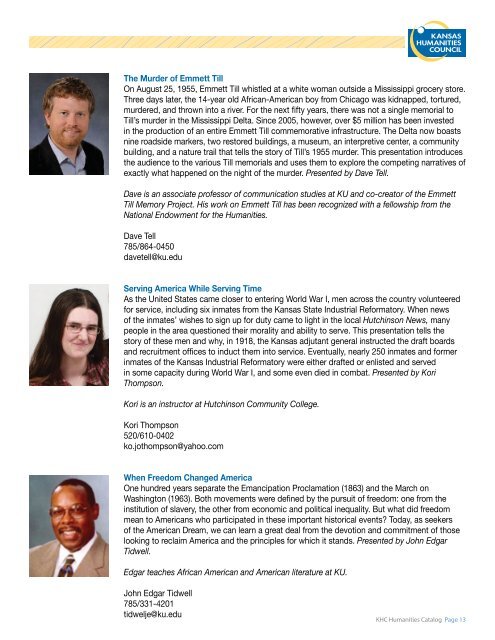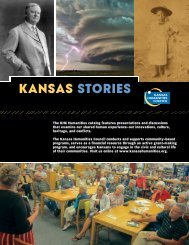KANSAS STORIES
1SvGw1V
1SvGw1V
Create successful ePaper yourself
Turn your PDF publications into a flip-book with our unique Google optimized e-Paper software.
The Murder of Emmett Till<br />
On August 25, 1955, Emmett Till whistled at a white woman outside a Mississippi grocery store.<br />
Three days later, the 14-year old African-American boy from Chicago was kidnapped, tortured,<br />
murdered, and thrown into a river. For the next fifty years, there was not a single memorial to<br />
Till’s murder in the Mississippi Delta. Since 2005, however, over $5 million has been invested<br />
in the production of an entire Emmett Till commemorative infrastructure. The Delta now boasts<br />
nine roadside markers, two restored buildings, a museum, an interpretive center, a community<br />
building, and a nature trail that tells the story of Till’s 1955 murder. This presentation introduces<br />
the audience to the various Till memorials and uses them to explore the competing narratives of<br />
exactly what happened on the night of the murder. Presented by Dave Tell.<br />
Dave is an associate professor of communication studies at KU and co-creator of the Emmett<br />
Till Memory Project. His work on Emmett Till has been recognized with a fellowship from the<br />
National Endowment for the Humanities.<br />
Dave Tell<br />
785/864-0450<br />
davetell@ku.edu<br />
Serving America While Serving Time<br />
As the United States came closer to entering World War I, men across the country volunteered<br />
for service, including six inmates from the Kansas State Industrial Reformatory. When news<br />
of the inmates’ wishes to sign up for duty came to light in the local Hutchinson News, many<br />
people in the area questioned their morality and ability to serve. This presentation tells the<br />
story of these men and why, in 1918, the Kansas adjutant general instructed the draft boards<br />
and recruitment offices to induct them into service. Eventually, nearly 250 inmates and former<br />
inmates of the Kansas Industrial Reformatory were either drafted or enlisted and served<br />
in some capacity during World War I, and some even died in combat. Presented by Kori<br />
Thompson.<br />
Kori is an instructor at Hutchinson Community College.<br />
Kori Thompson<br />
520/610-0402<br />
ko.jothompson@yahoo.com<br />
When Freedom Changed America<br />
One hundred years separate the Emancipation Proclamation (1863) and the March on<br />
Washington (1963). Both movements were defined by the pursuit of freedom: one from the<br />
institution of slavery, the other from economic and political inequality. But what did freedom<br />
mean to Americans who participated in these important historical events? Today, as seekers<br />
of the American Dream, we can learn a great deal from the devotion and commitment of those<br />
looking to reclaim America and the principles for which it stands. Presented by John Edgar<br />
Tidwell.<br />
Edgar teaches African American and American literature at KU.<br />
John Edgar Tidwell<br />
785/331-4201<br />
tidwelje@ku.edu<br />
KHC Humanities Catalog Page 13



